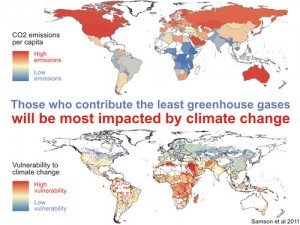Dickinson to Durban » Climate Change, Environmental Justice, Key COP17 Issues, Mosaic Action, Student Research » A look at the positions of the most vulnerable countries of the world
A look at the positions of the most vulnerable countries of the world
By Anna McGinn ‘14
 Together they do not emit enough to tangibly affect the atmospheric levels of carbon dioxide, yet they are feeling the impacts the most. Climate change is not a thing of the future for these countries, it is happening now. However, for the most part these countries do not have much political power in the international negotiations to actually push through changes that will save their countries. The most vulnerable countries are in a tough position right now, and it is hard to see how they will be able to overcome these obstacles.
Together they do not emit enough to tangibly affect the atmospheric levels of carbon dioxide, yet they are feeling the impacts the most. Climate change is not a thing of the future for these countries, it is happening now. However, for the most part these countries do not have much political power in the international negotiations to actually push through changes that will save their countries. The most vulnerable countries are in a tough position right now, and it is hard to see how they will be able to overcome these obstacles.
Before the conference, a group of the most vulnerable countries (Bangladesh, Costa Rica, Bhutan, Nepal, St. Lucia, the Maldives, etc.) met in Dhaka, Bangladesh to discuss their positions in the negotiations. This meeting resulted in the Dhaka Declaration which states the point of view of these vulnerable nations. During the conference, these delegations are pushing together to see these points come to fruitions.
First, these countries feel that it is imperative that a second commitment period to the Kyoto Protocol is agreed upon. Developed countries must be bound to an agreement to lower emissions. In addition, these countries say in the Declaration that they “resolve to demonstrate moral leadership by committing to a low-carbon development path.”
Second, they want the solidification of the Green Climate Fund. These countries need money to adapt to climate change because they are the countries most deeply affected, but they do not have the resources to do so. The polluters should pay for the impacts.
Third, the declaration states that they “declare that the most vulnerable countries need critical support from the international community in the areas of technology transfer” for adaptation and mitigation. With this technology, the vulnerable countries will be able to adapt more fluidly to the major problems they are facing.
Fourth, they see the necessity and urgency of compromise. The vulnerable countries cannot wait any longer for substantial action to be taken because soon the impacts will be too severe to overcome in their regions of the world.
When it comes down to it, the fate of most of these countries is in the hands of high emitting, powerful nations who are not willing or politically able to make strong enough commitments to emissions reductions. It will be interesting to see if any of the hopes of the most vulnerable countries will be realized during COP17.
Filed under: Climate Change, Environmental Justice, Key COP17 Issues, Mosaic Action, Student Research · Tags: adaptation, Anna McGinn, Dhaka Declaration, Green Climate Fund, Kyoto Protocol








Recent Comments